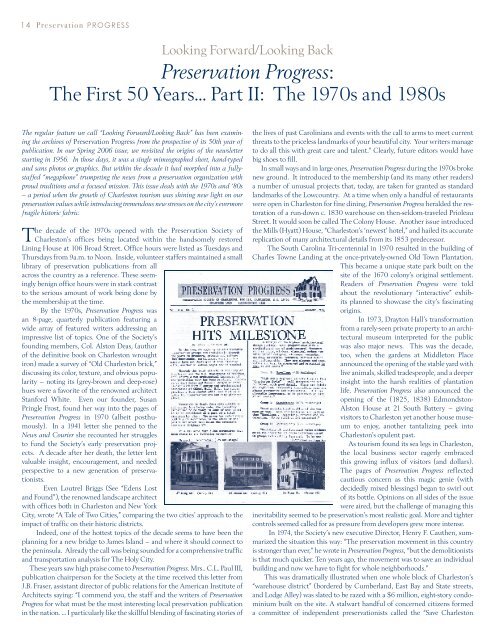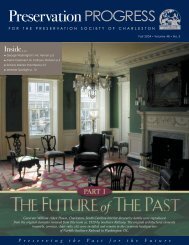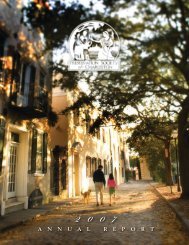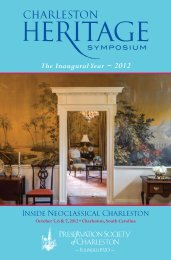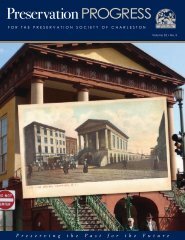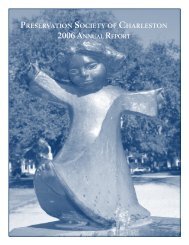download pdf - Preservation Society of Charleston
download pdf - Preservation Society of Charleston
download pdf - Preservation Society of Charleston
- No tags were found...
You also want an ePaper? Increase the reach of your titles
YUMPU automatically turns print PDFs into web optimized ePapers that Google loves.
14 <strong>Preservation</strong> PROGRESS<br />
Looking Forward/Looking Back<br />
<strong>Preservation</strong> Progress:<br />
The First 50 Years… Part II: The 1970s and 1980s<br />
The regular feature we call “Looking Forward/Looking Back” has been examining<br />
the archives <strong>of</strong> <strong>Preservation</strong> Progress from the prospective <strong>of</strong> its 50th year <strong>of</strong><br />
publication. In our Spring 2006 issue, we revisited the origins <strong>of</strong> the newsletter<br />
starting in 1956. In those days, it was a single mimeographed sheet, hand-typed<br />
and sans photos or graphics. But within the decade it had morphed into a fullystaffed<br />
“megaphone” trumpeting the news from a preservation organization with<br />
proud traditions and a focused mission. This issue deals with the 1970s and ‘80s<br />
— a period when the growth <strong>of</strong> <strong>Charleston</strong> tourism was shining new light on our<br />
preservation values while introducing tremendous new stresses on the city’s evermore<br />
fragile historic fabric.<br />
The decade <strong>of</strong> the 1970s opened with the <strong>Preservation</strong> <strong>Society</strong> <strong>of</strong><br />
<strong>Charleston</strong>’s <strong>of</strong>fices being located within the handsomely restored<br />
Lining House at 106 Broad Street. Office hours were listed as Tuesdays and<br />
Thursdays from 9a.m. to Noon. Inside, volunteer staffers maintained a small<br />
library <strong>of</strong> preservation publications from all<br />
across the country as a reference. These seemingly<br />
benign <strong>of</strong>fice hours were in stark contrast<br />
to the serious amount <strong>of</strong> work being done by<br />
the membership at the time.<br />
By the 1970s, <strong>Preservation</strong> Progress was<br />
an 8-page, quarterly publication featuring a<br />
wide array <strong>of</strong> featured writers addressing an<br />
impressive list <strong>of</strong> topics. One <strong>of</strong> the <strong>Society</strong>’s<br />
founding members, Col. Alston Deas, (author<br />
<strong>of</strong> the definitive book on <strong>Charleston</strong> wrought<br />
iron) made a survey <strong>of</strong> “Old <strong>Charleston</strong> brick,”<br />
discussing its color, texture, and obvious popularity<br />
– noting its (grey-brown and deep-rose)<br />
hues were a favorite <strong>of</strong> the renowned architect<br />
Stanford White. Even our founder, Susan<br />
Pringle Frost, found her way into the pages <strong>of</strong><br />
<strong>Preservation</strong> Progress in 1970 (albeit posthumously).<br />
In a 1941 letter she penned to the<br />
News and Courier she recounted her struggles<br />
to fund the <strong>Society</strong>’s early preservation projects.<br />
A decade after her death, the letter lent<br />
valuable insight, encouragement, and needed<br />
perspective to a new generation <strong>of</strong> preservationists.<br />
Even Loutrel Briggs (See “Edens Lost<br />
and Found”), the renowned landscape architect<br />
with <strong>of</strong>fices both in <strong>Charleston</strong> and New York<br />
City, wrote “A Tale <strong>of</strong> Two Cities,” comparing the two cities’ approach to the<br />
impact <strong>of</strong> traffic on their historic districts.<br />
Indeed, one <strong>of</strong> the hottest topics <strong>of</strong> the decade seems to have been the<br />
planning for a new bridge to James Island – and where it should connect to<br />
the peninsula. Already the call was being sounded for a comprehensive traffic<br />
and transportation analysis for The Holy City.<br />
These years saw high praise come to <strong>Preservation</strong> Progress. Mrs.. C.L. Paul III,<br />
publication chairperson for the <strong>Society</strong> at the time received this letter from<br />
J.B. Fraser, assistant director <strong>of</strong> public relations for the American Institute <strong>of</strong><br />
Architects saying: “I commend you, the staff and the writers <strong>of</strong> <strong>Preservation</strong><br />
Progress for what must be the most interesting local preservation publication<br />
in the nation. … I particularly like the skillful blending <strong>of</strong> fascinating stories <strong>of</strong><br />
the lives <strong>of</strong> past Carolinians and events with the call to arms to meet current<br />
threats to the priceless landmarks <strong>of</strong> your beautiful city. Your writers manage<br />
to do all this with great care and talent.” Clearly, future editors would have<br />
big shoes to fill.<br />
In small ways and in large ones, <strong>Preservation</strong> Progress during the 1970s broke<br />
new ground. It introduced to the membership (and its many other readers)<br />
a number <strong>of</strong> unusual projects that, today, are taken for granted as standard<br />
landmarks <strong>of</strong> the Lowcountry. At a time when only a handful <strong>of</strong> restaurants<br />
were open in <strong>Charleston</strong> for fine dining, <strong>Preservation</strong> Progress heralded the restoration<br />
<strong>of</strong> a run-down c. 1830 warehouse on then-seldom-traveled Prioleau<br />
Street. It would soon be called The Colony House. Another issue introduced<br />
the Mills (Hyatt) House, “<strong>Charleston</strong>’s ‘newest’ hotel,” and hailed its accurate<br />
replication <strong>of</strong> many architectural details from its 1853 predecessor.<br />
The South Carolina Tri-centennial in 1970 resulted in the building <strong>of</strong><br />
Charles Towne Landing at the once-privately-owned Old Town Plantation.<br />
This became a unique state park built on the<br />
site <strong>of</strong> the 1670 colony’s original settlement.<br />
Readers <strong>of</strong> <strong>Preservation</strong> Progress were told<br />
about the revolutionary “interactive” exhibits<br />
planned to showcase the city’s fascinating<br />
origins.<br />
In 1973, Drayton Hall’s transformation<br />
from a rarely-seen private property to an architectural<br />
museum interpreted for the public<br />
was also major news. This was the decade,<br />
too, when the gardens at Middleton Place<br />
announced the opening <strong>of</strong> the stable yard with<br />
live animals, skilled tradespeople, and a deeper<br />
insight into the harsh realities <strong>of</strong> plantation<br />
life. <strong>Preservation</strong> Progress also announced the<br />
opening <strong>of</strong> the (1825, 1838) Edmondston-<br />
Alston House at 21 South Battery – giving<br />
visitors to <strong>Charleston</strong> yet another house museum<br />
to enjoy, another tantalizing peek into<br />
<strong>Charleston</strong>’s opulent past.<br />
As tourism found its sea legs in <strong>Charleston</strong>,<br />
the local business sector eagerly embraced<br />
this growing influx <strong>of</strong> visitors (and dollars).<br />
The pages <strong>of</strong> <strong>Preservation</strong> Progress reflected<br />
cautious concern as this magic genie (with<br />
decidedly mixed blessings) began to swirl out<br />
<strong>of</strong> its bottle. Opinions on all sides <strong>of</strong> the issue<br />
were aired, but the challenge <strong>of</strong> managing this<br />
inevitability seemed to be preservation’s most realistic goal. More and tighter<br />
controls seemed called for as pressure from developers grew more intense.<br />
In 1974, the <strong>Society</strong>’s new executive Director, Henry F. Cauthen, summarized<br />
the situation this way: “The preservation movement in this country<br />
is stronger than ever,” he wrote in <strong>Preservation</strong> Progress, “but the demolitionists<br />
is that much quicker. Ten years ago, the movement was to save an individual<br />
building and now we have to fight for whole neighborhoods.”<br />
This was dramatically illustrated when one whole block <strong>of</strong> <strong>Charleston</strong>’s<br />
“warehouse district” (bordered by Cumberland, East Bay and State streets,<br />
and Lodge Alley) was slated to be razed with a $6 million, eight-story condominium<br />
built on the site. A stalwart handful <strong>of</strong> concerned citizens formed<br />
a committee <strong>of</strong> independent preservationists called the “Save <strong>Charleston</strong>


